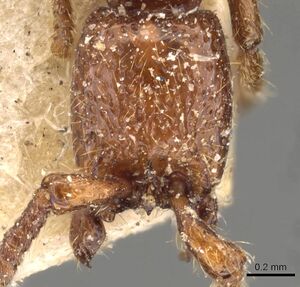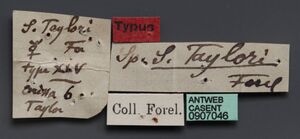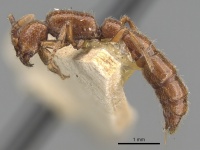Eusphinctus taylori
| Eusphinctus taylori | |
|---|---|

| |
| Scientific classification | |
| Kingdom: | Animalia |
| Phylum: | Arthropoda |
| Class: | Insecta |
| Order: | Hymenoptera |
| Family: | Formicidae |
| Subfamily: | Dorylinae |
| Genus: | Eusphinctus |
| Species: | E. taylori |
| Binomial name | |
| Eusphinctus taylori Forel, 1900 | |
Identification
Jaitrong et al. (2016) - Eusphinctus furcatus is similar to Eusphinctus taylori in general appearance as they share the pygidial apex deeply notched (as seen from above), 11-segmented antenna, reddish brown body and swollen mesosoma. However, E. furcatus is easily separated from E. taylori by the following conditions: body larger (WL 1.68-1.78 mm in E. furcatus while WL 1.27 mm in E. taylori); petiole longer than broad (broader than long in E. taylori); body color darker (deep reddish brown in E. furcatus while light reddish brown in E. taylori).
- Larger species (WL 1.68-1.78 mm); body deep reddish brown; petiolar node longer than broad (India, Myanmar, and Thailand) . . . . . Eusphinctus furcatus
- Smaller species (WL 1.27 mm); body light reddish brown; petiolar node broader than long (India) . . . . . Eusphinctus taylori
Distribution
Latitudinal Distribution Pattern
Latitudinal Range: 23.5° to 23.5°.
| North Temperate |
North Subtropical |
Tropical | South Subtropical |
South Temperate |
- Source: AntMaps
Distribution based on Regional Taxon Lists
Oriental Region: Bangladesh, India (type locality).
Distribution based on AntMaps
Distribution based on AntWeb specimens
Check data from AntWeb
Countries Occupied
| Number of countries occupied by this species based on AntWiki Regional Taxon Lists. In general, fewer countries occupied indicates a narrower range, while more countries indicates a more widespread species. |

|
Estimated Abundance
| Relative abundance based on number of AntMaps records per species (this species within the purple bar). Fewer records (to the left) indicates a less abundant/encountered species while more records (to the right) indicates more abundant/encountered species. |

|
Biology
Castes
Worker
Images from AntWeb
   
| |
| Syntype of Sphinctomyrmex taylori. Worker. Specimen code casent0907046. Photographer Z. Lieberman, uploaded by California Academy of Sciences. | Owned by MHNG, Geneva, Switzerland. |
Nomenclature
The following information is derived from Barry Bolton's Online Catalogue of the Ants of the World.
- taylori. Sphinctomyrmex (Eusphinctus) taylori Forel, 1900d: 328 (w.) INDIA (Odisha).
- Type-material: syntype workers (number not stated).
- Type-locality: India: Orissa (Taylor).
- Type-depositories: MHNG, MSNG.
- Combination in Eusphinctus: Borowiec, M.L. 2016: 144.
- Status as species: Bingham, 1903: 25; Emery, 1911d: 7; Chapman & Capco, 1951: 21; Brown, 1975: 33, 75; Bolton, 1995b: 392; Bharti, Guénard, et al. 2016: 22; Jaitrong, Wiwatwitaya & Sakchoowong, 2016: 3 (in key).
- Distribution: India.
Description
Worker
Bingham (1903): Closely resembles S. furcatus, Emery, but is smaller, and the pygidium is not so deeply bifurcate. Brownish yellow, covered with partly erect, short pale hairs; pubescence almost entirely absent. Head, thorax, node of the pedicel above and basal abdominal segment somewhat coarsely punctured, most densely on the head and basal abdominal segment, and very sparsely on the thorax above, which is smooth and shining. Head longer than broad, emarginate posteriorly; mandibles densely punctured: antennal hollows margined on the outside by an arcuate carina; antennae very massive and thick. Thorax with the basal face of the metanotum passing into the apical face by an abrupt curve, the latter margined only at the sides, not above. Node of the pedicel about as broad as long, slightly rounded at the corners, convex above abdomen: the 2nd and succeeding segments with fine, rather scattered punctures; pygidium concave, incised at apex, and with the lateral margins spinulose.
Length: 5 - 5.5 mm
References
- Borowiec, M.L. 2016. Generic revision of the ant subfamily Dorylinae (Hymenoptera, Formicidae). ZooKeys 608: 1-280 (doi:10.3897/zookeys.608.9427).
- Forel, A. 1900f. Les Formicides de l'Empire des Indes et de Ceylan. Part VII. J. Bombay Nat. Hist. Soc. 13: 303-332 (page 328, worker described)
- Jaitrong, W., Wiwatwitaya, D. & Sakchoowong, W. 2016. Review of the Thai species of the genus Sphinctomyrmex Mayr, 1866 (Hymenoptera: Formicidae, Dorylinae), with description of a new species. Far Eastern Entomologist. 305:1-9.
References based on Global Ant Biodiversity Informatics
- Basu P., N. Tak, and A. K. Sanyal. 2013. Ants (insecta: Hymenoptera: Formicidae) of Bethuadahari wildlife sanctuary, Nadia, West Bengal, India. Rec. zool, Surv. India: 113(4): 17-22.
- Bharti H., B. Guénard, M. Bharti, & E. P. Economo. 2015. An updated checklist of the ants (Hymenoptera: Formicidae) of India with their specific distributions in Indian states. Zookeys
- Brown W. L., Jr. 1975. Contributions toward a reclassification of the Formicidae. V. Ponerinae, tribes Platythyreini, Cerapachyini, Cylindromyrmecini, Acanthostichini, and Aenictogitini. Search Agric. (Ithaca N. Y.) 5(1): 1-115.
- Chapman, J. W., and Capco, S. R. 1951. Check list of the ants (Hymenoptera: Formicidae) of Asia. Monogr. Inst. Sci. Technol. Manila 1: 1-327
- Emery C. 1911. Hymenoptera. Fam. Formicidae. Subfam. Ponerinae. Genera Insectorum 118: 1-125.
- Forel A. 1900. Les Formicides de l'Empire des Indes et de Ceylan. Part VII. J. Bombay Nat. Hist. Soc. 13: 303-332.
- Tiwari R.N., B.G. Kundu, S. Roychowdhury, S.N. Ghosh. 1999. Insecta: Hymenoptera: Formicidae. Pp. 211-294 in: Director; Zoological Survey of India (ed.) 1999. Fauna of West Bengal. Part 8. Insecta (Trichoptera, Thysanoptera, Neuroptera, Hymenoptera and Anoplura). Calcutta: Zoological Survey of India, iv + 442 pp.

